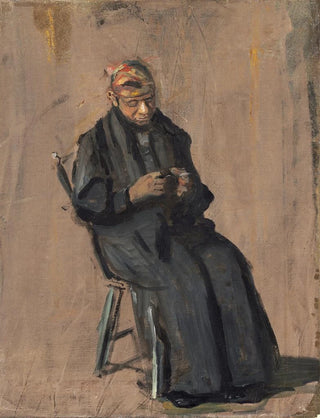Art print | The Little Red Riding Hood - Thomas Eakins


View from behind

Frame (optional)
In the vast panorama of art history, certain works stand out for their ability to capture the very essence of humanity. "The Cloak" by Thomas Eakins is undoubtedly one of those creations that transcend the simple pictorial frame to offer an immersion into a world rich in emotions and stories. This piece, imbued with realism, transports us to a time when faithful representation of everyday life was at the heart of artistic concerns. Through delicate strokes and harmonious composition, Eakins invites us to contemplate a moment frozen in time, where every detail seems to tell a story.
Style and uniqueness of the work
Thomas Eakins's style is characterized by striking realism, an approach that allows him to capture nuances of light and shadow, as well as human expressions with remarkable precision. In "The Cloak," the artist deploys a subtle color palette, where warm tones and delicate shadows blend to create an intimate atmosphere. The central figure, wrapped in a cloak, embodies both vulnerability and strength—a duality that resonates deeply with the viewer. The meticulous details, from the folds of the fabric to the reflections in the eyes, testify to Eakins's expertise in anatomy and his commitment to a faithful representation of reality. This work also stands out for its ability to evoke universal emotions, allowing each viewer to identify with it and find a personal echo.
The artist and his influence
Thomas Eakins, an emblematic figure of 19th-century American realism, knew how to mark his era with his innovative approach and desire to transcend artistic conventions. Trained at the École des Beaux-Arts in Paris, he incorporated elements of European painting while remaining deeply rooted in American culture. His influence extends beyond his own works, inspiring a generation of artists to explore similar themes of truth and authenticity. Eakins was also a passionate advocate for artistic education, teaching many students and transmitting his passion for painting and drawing. His legacy endures in the

Matte finish

View from behind

Frame (optional)
In the vast panorama of art history, certain works stand out for their ability to capture the very essence of humanity. "The Cloak" by Thomas Eakins is undoubtedly one of those creations that transcend the simple pictorial frame to offer an immersion into a world rich in emotions and stories. This piece, imbued with realism, transports us to a time when faithful representation of everyday life was at the heart of artistic concerns. Through delicate strokes and harmonious composition, Eakins invites us to contemplate a moment frozen in time, where every detail seems to tell a story.
Style and uniqueness of the work
Thomas Eakins's style is characterized by striking realism, an approach that allows him to capture nuances of light and shadow, as well as human expressions with remarkable precision. In "The Cloak," the artist deploys a subtle color palette, where warm tones and delicate shadows blend to create an intimate atmosphere. The central figure, wrapped in a cloak, embodies both vulnerability and strength—a duality that resonates deeply with the viewer. The meticulous details, from the folds of the fabric to the reflections in the eyes, testify to Eakins's expertise in anatomy and his commitment to a faithful representation of reality. This work also stands out for its ability to evoke universal emotions, allowing each viewer to identify with it and find a personal echo.
The artist and his influence
Thomas Eakins, an emblematic figure of 19th-century American realism, knew how to mark his era with his innovative approach and desire to transcend artistic conventions. Trained at the École des Beaux-Arts in Paris, he incorporated elements of European painting while remaining deeply rooted in American culture. His influence extends beyond his own works, inspiring a generation of artists to explore similar themes of truth and authenticity. Eakins was also a passionate advocate for artistic education, teaching many students and transmitting his passion for painting and drawing. His legacy endures in the






